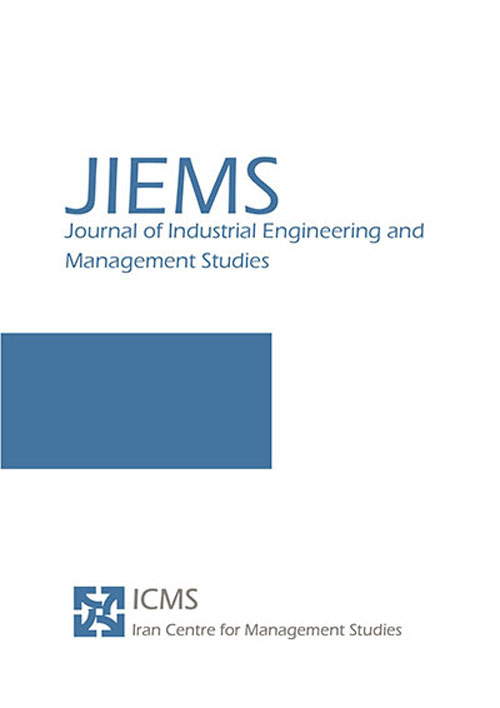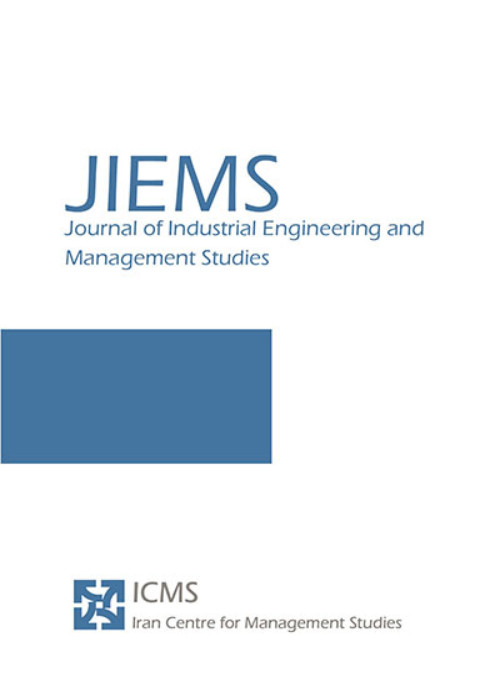فهرست مطالب

Journal of Industrial Engineering and Management Studies
Volume:6 Issue: 1, Winter-Spring 2019
- تاریخ انتشار: 1398/04/10
- تعداد عناوین: 6
-
-
Pages 1-17The nature of input materials is changed as long as the product reaches the consumer in many types of manufacturing processes. In designing and improving multi-stage systems, the study of the steps separately may not lead to the greatest possible improvement in the whole system, therefore the study of inputs and outputs of each stage can be effective in improving the output quality characteristics. In this study, the double sampling method is applied for inspection where decision variables are the sample size per sampling time and the maximum amount of defective items in the first and second samples in each stage. Furthermore, uncertainty in parameters such as production, inspection, and replacement costs are included in the objective function and handled by a Monte-Carlo based optimization method. In order to show the efficacies of the proposed method, a numerical example has been designed, and further analyses on solutions have been conducted.Keywords: Double sampling plan, Genetic Algorithm, Monte Carlo Optimization, Inspection Error, Multistage Systems
-
Pages 18-45In this paper, we consider a newsvendor who is going to invest on dedicated or flexible capacity, our goal is to find the optimal investment policy to maximize total profit while the newsvendor faces uncertainty in lead time and demand simultaneously. As highlighted in literature, demand is stochastic, while lead time is constant. However, in reality lead time uncertainty decreases newsvendor's performance and increases purchasing cost. Analytical results suggest an approach for decision makers to decide which situation is optimal to invest in flexible capacity. Furthermore, we derive a closed-form solution for optimal production and capacity under dedicated and flexible policy when demand and lead time follow uniform and normal distribution. An approximation method introduced in this paper to find the optimal production quantity and investment policy results show that this approximation is useful when the coefficient of variation is low under uniform distribution, and it is useful when the coefficient of variation is high under normal distribution. Finally, we show a threshold, considering the fact that it is optimal for the newsvendor to invest on flexible capacity when flexible capacity cost is less than the threshold. To sum up, we measure the effect of lead time variability on optimal solution.Keywords: Flexible Capacity, stochastic demand, Stochastic Lead-time, Newsboy problem, Lagrangian Optimization
-
Pages 45-66Control charts are powerful tools to monitor quality characteristics of services or production processes. However, in some processes, the performance of process or product cannot be controlled by monitoring a characteristic; instead, they require to be controlled by a function that usually refers as a profile. This study suggests employing exponentially weighted moving average (EWMA) and range (R) control charts for profile monitoring, simultaneously. For this purpose, the parameters of these control charts should be determined in a way that the expected total cost is minimized. In order to evaluate the statistical performance of the proposed model, the in-control and out-of-control average run lengths are applied. Moreover, the existence of uncertain parameters in many processes is a barrier to attain the best design of control charts in practice. In this paper, the economic-statistical design of control charts for linear profile monitoring under uncertain conditions is investigated. A genetic algorithm is used for solving the proposed robust model, and the Taguchi experimental design is employed for tuning its parameters. Furthermore, the effectiveness of the developed model is illustrated through a numerical example.Keywords: exponentially weighted moving average chart, range chart, Economic-Statistical Design, profile monitoring, robust optimization
-
Pages 68-78Prediction of stock returns has always been one of the most important issues in finance. Investors have attracted to use of Fama-French Five-Factor Model (FFFFM) as one of the powerful methods for pricing financial assets and predicting the stock returns. This research investigates the predictability of stock returns by including some important firms features namely cash holdings, dividend rate, and free cash flow to equity to FFFFM. Statistical samples consist of 75 companies listed on the Tehran Stock Exchange (TSE) during 2003-2017. The results of panel data test indicate positive significant effects of all variables in FFFFM (i.e. book to market value ratio, company size, growth opportunity, profitability, and investment) as well as newly added firms feature variables (cash holding, dividend rate, and free cash flow to equity). However, the investment has a negative impact on the returns due to the initial estimate of primary FFFFM. In addition, the results indicate that the inclusion of firms feature variables significantly improve the predictive power of stock returns. Finally, by comparing the predictive power of the models, the best prediction model is determined.Keywords: Stock Return, Fama-French Five-Factor model, cash holdings, dividend rate, free cash flow to equity
-
Pages 79-110In this paper, an inventory model for deterioration items in a two-echelon supply chain including one retailer and one manufacturer is proposed by considering the stock and price dependent demand and capacity constraint for holding inventories. First, the model is presented as a leader-follower game in which the manufacturer announces wholesale prices. Second, the retailer decides for the order quantity and price of the items based on the wholesale prices. Then, by introducing the integrated model of the supply chain, a cost-sharing contract is applied to coordinate the manufacturer and the retailer. On the other hand, by using the convergence properties of the model and proving non-concavity of the problem, a meta-heuristic algorithm, namely iterative local search (ILS) is proposed to solve the models. The results show the determinant role of the capacity constraint on the optimal decisions and the ability of the proposed contract to coordinate the supply chain. Moreover, it is shown that the proposed algorithm outperforms the well-known interior point algorithm as the results of the initiations embedded in it for the special problem.Keywords: Deterioration items, Stock, price dependent demand, two echelon supply chain, supply chain coordination, cost sharing contract
-
Pages 111-129However, there is a lot of capital and plenty of manpower in the auto spare part industry, the enterprises and supply chains of this industry do not perform well in our country. This research models a three-level supply chain with multiple manufacturers, distribution centers and retailers, to minimize the total cost by taking into account various disruptions. The database of two active car spare parts companies for five strategic products in one year has been used. Then, the mathematical model is analyzed by considering disruptions based on three different sales policies: back orders, lost sales and outsourcing. Besides, to evaluate the performance of the model some numerical examples are used and analyzed to determine that algorithm works. Model solved efficiently by MATLAB software. The results show that the proposed algorithm of this research can neutralize the effect of the disruptions and cause a significant reduction in total cost of the system. The model is useful for helping decision makers to adopt an active approach to maintaining business benefits when disruptions take place in the supply chain.Keywords: Optimization model, Fuzzy, Auto parts supply chain, Disruption


